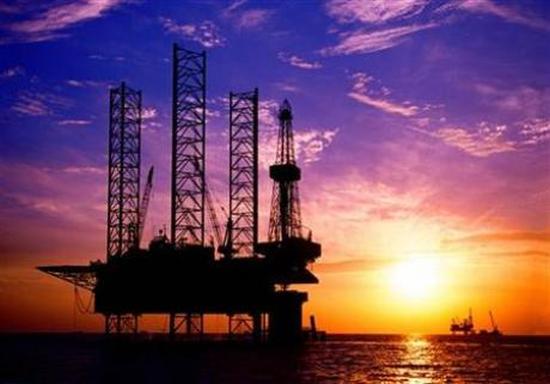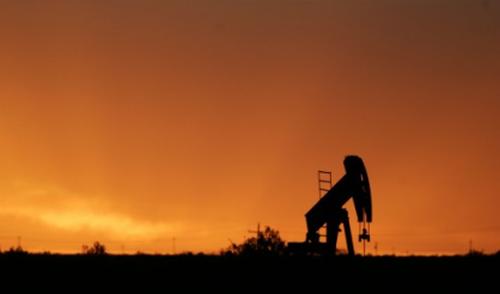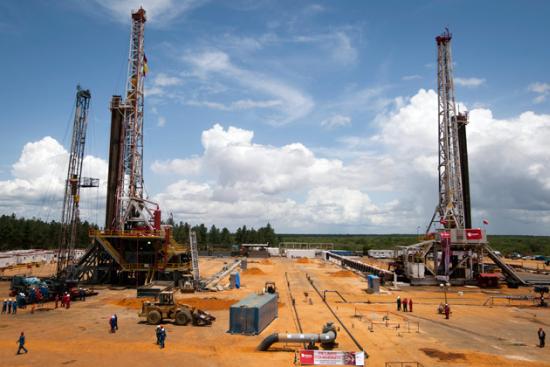Photographs: Reuters Ajay Modi in New Delhi
ONGC Videsh Ltd, or OVL, the overseas arm of state-owned Oil & Natural Gas Corporation (ONGC), will pay $5 billion to acquire ConocoPhillips's 8.4 per cent stake in a Kazakhstan oilfield.
The Kashagan field, located in the shallow waters of the Kazakh North Caspian Sea, is the world's largest development project. The acquisition of the stake is likely to be completed by the first half of 2013. Production will start from mid-2013.
OVL, with its 8.4 per cent stake, will get 315,000 tonnes of oil in the first year. The share will go up to 4.2 million tonnes per annum in 2028 when all the three phases of the field have been fully developed.
This will help OVL offset the drop in production from its assets in Syria and Sudan, which had brought its total output down by 7 per cent in 2011-12.
Some analysts have raised doubts on the wisdom of the deal. Though the Kashagan field has been under development for 12 years, involving an investment of almost $50 billion, the output isn't great.
The cost overruns will mean thin margins for the owners of the field: KazMunaiGas of Kazakhstan, Exxon Mobil, Royal Dutch Shell, Total and now OVL. ConocoPhillips's "investors should be happy to see the costly project in central Asia go," one analyst had said.
Did OVL overpay? OVL director (finance) S P Garg says the price was right: "Only the future will prove who was right and who was wrong."
D K Sarraf, OVL's managing director, had said after the Kashagan acquisition the company's appetite to acquire more assets remains and it is looking for opportunities in the US and North America. It also sees opportunities in parts of Africa, East Africa, Brazil, Venezuela, Colombia, central Asian countries and Russia.
...
Is OVL making the right acquisitions?
Image: An oil rig is silhouetted against the sunsetPhotographs: Jessica Rinaldi/Reuters
What bothers analysts is the earlier big-ticket acquisition done by OVL in January 2009 when it had bought Imperial Energy Corporation, an independent upstream oil exploration and production company, with its main activities in the Tomsk region of Western Siberia, for $2.1 billion.
OVL invested another about $500 million in the asset. However, it is currently producing only 15,000 barrels of oil per day against the projected 80,000 barrels.
Way ahead
OVL says it has drawn a road map to revive the sagging output by induction of new technology from the next financial year. The company has invited expression of interest for gaining access to new technology to produce oil by drilling wells this year.
"We are finding a suitable technology to produce oil from the right reservoirs. The entire area of Imperial has shale and is known to be oil-bearing. We are looking for a technology partner to extract the same. In addition to these two, we (the industry in the region) are also hopeful of getting fiscal concessions from the government. The twin impact will improve the financials from Imperial," says Garg.
Incidentally, OVL had to book an impairment of Rs 1, 953 crore (Rs 19.53 billion) last fiscal due to lower performance from the asset.
The company is concerned about Imperial's operations. "We are trying to introspect and evaluate what went wrong. We want to ensure such instances do not occur in the future," he adds.
Garg believes one should not single out the Imperial deal to assess OVL's performance. "While evaluating OVL's performance, one should adopt the approach applied to a mutual fund where negative performance of a few stocks is not relevant as long as the overall portfolio is healthy."
...
Is OVL making the right acquisitions?
Photographs: Carlos Garcia Rawlings/Reuters
The Imperial investment notwithstanding, OVL is in sound financial health. It reported a revenue of Rs 22,637 crore (Rs 226.37 billion) and profit of Rs 2,721 crore (Rs 27.21 billion) in 2011-12.
Reflecting the good performance, the debt-equity ratio of OVL has decreased considerably from 10 in 2003-04 to less than 1 now. It has been financing about 70 per cent of investments from internal resources. But, is that good enough for OVL to take on the Chinese in the quest for securing energy assets across the world?
India has lagged China in acquiring energy assets worldwide and it is now keen to collaborate with China in this area. Chinese state oil companies like CNOOC, Sinopec and PetroChina have been among the world's most acquisitive oil firms in recent years.
With their financial independence, these Chinese companies have been very successful in sealing big acquisitions, while Indian public sector energy companies have not been as successful in closing big overseas acquisitions owing to delays in securing government approvals.
"We can't really compete with China. The best thing would be to collaborate with China," ONGC chairman Sudhir Vasudeva had said recently. ONGC and China National Petroleum Corporation (CNPC) are thus forming teams that will jointly look for assets to meet the growing energy needs of India and China.
OVL currently has a presence in 31 exploration and production projects in 15 countries (Vietnam, Iraq, Libya, Syria, Sudan, South Sudan, Iran, Cuba, Brazil, Venezuela, Russia, Myanmar, Colombia, Nigeria and Kazakhstan).
The company's website says it is the company's vision and objective to provide energy security to the nation. However, one may question how does it ensure security for the nation when it ends up selling all its produce internationally?
Garg makes a point by saying that acquiring and operating assets overseas does not make a difference to the country so long as oil is freely available in the international market.
"One must realise that as a company, we have control over the quantity of oil that we produce and in case of an emergency, that quantity can be imported to India. We have, in the past, brought several cargoes of crude from our overseas assets to Mangalore Refineries," says Garg.
Spurring exploration
Its success has also prompted other state-owned oil companies to join the global hunt for oil and gas.
...
Is OVL making the right acquisitions?
Photographs: Sergei Karpukhin/Reuters
Bharat Petroleum's exploration firm, Bharat PetroResources, has interests in 15 overseas exploration blocks, primarily in Brazil. IndianOil has teamed up with Oil India (OIL) for its overseas exploration ventures.
Oil India is also planning to float an overseas investment arm on the lines of OVL. Earlier, OIL and Indian Oil Corporation had set up a Mauritius-based special entity, Ind-Oil Overseas, in 2008, for acquiring oil and gas acreages overseas.
But, the special purpose vehicle no longer exists, and till its closure, the venture did not acquire assets. Ind-Oil Overseas was to look at prospects in the CIS and African countries.
OVL has played its cards fairly well by exercising a fair degree of risk mitigation in most of the projects by partnering with some of the leading international oil and gas names like Exxon, Shell, Rosneft, Total, ENI, Petrobras, CNPC, Sinopec and Petronas.
It is expecting good results out of the exploration prospects over the next couple of years. If proved successful in these ventures, the company shall be adding reserves through the drill-bit mechanism, thereby considerably reducing its overall acquisition cost of reserves.
However, the company's business faces the biggest threats in terms of highly volatile oil prices, geopolitical factors and changes in tax regime of countries.
It had to take a hit of Rs 808 crore (Rs 8.08 billion) last financial year, as the Venezuelan government imposed a windfall tax on the San Cristobal project. Its business in Sudan and Syria has been affected due to geopolitical reasons.
The company participates and operates in varied environments, both politically and geographically, where exploration, production and development is more challenging technologically, operationally and financially.
ONGC Videsh had earlier set a production target of 20 million tonnes of oil and gas by 2020. However, this target date was advanced to 2018 in November last year. Further, a target of 60 million tonnes was set to be achieved by 2030.
As the production targets are quite steep, involving compound annual growth of more than 14 per cent up to 2017-18 and 9 per cent from then to 2030, OVL needs to concentrate on acquiring assets in development and production phase initially and then concentrate on high potential exploration acreages and also venture capitalist type of opportunities.
This will involve substantial fund requirement - to the tune of $20 billion. The company needs to keep its balance sheet deleveraged for this.
This will also require acquiring, retention and training of manpower with special skill sets, revamping of many internal processes and taking a relook at the way business development is to be done in future.






article